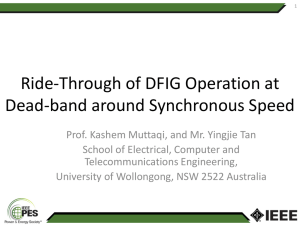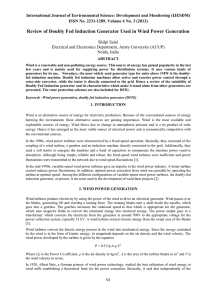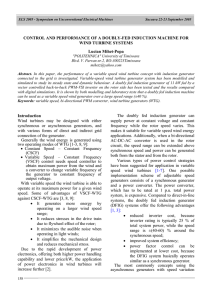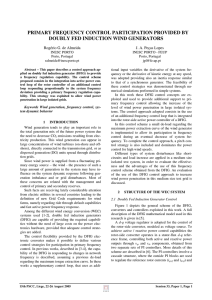Transient Behavior of Doubly Fed Induction Generator Using
advertisement
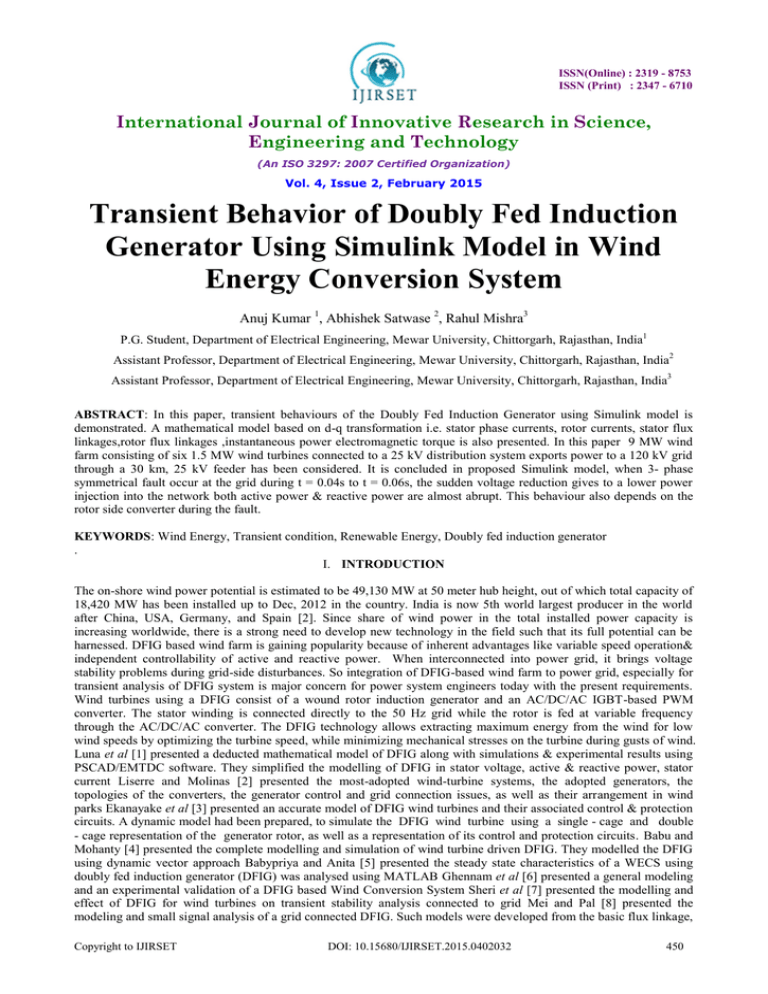
ISSN(Online) : 2319 - 8753 ISSN (Print) : 2347 - 6710 International Journal of Innovative Research in Science, Engineering and Technology (An ISO 3297: 2007 Certified Organization) Vol. 4, Issue 2, February 2015 Transient Behavior of Doubly Fed Induction Generator Using Simulink Model in Wind Energy Conversion System Anuj Kumar 1, Abhishek Satwase 2, Rahul Mishra3 P.G. Student, Department of Electrical Engineering, Mewar University, Chittorgarh, Rajasthan, India1 Assistant Professor, Department of Electrical Engineering, Mewar University, Chittorgarh, Rajasthan, India2 Assistant Professor, Department of Electrical Engineering, Mewar University, Chittorgarh, Rajasthan, India3 ABSTRACT: In this paper, transient behaviours of the Doubly Fed Induction Generator using Simulink model is demonstrated. A mathematical model based on d-q transformation i.e. stator phase currents, rotor currents, stator flux linkages,rotor flux linkages ,instantaneous power electromagnetic torque is also presented. In this paper 9 MW wind farm consisting of six 1.5 MW wind turbines connected to a 25 kV distribution system exports power to a 120 kV grid through a 30 km, 25 kV feeder has been considered. It is concluded in proposed Simulink model, when 3- phase symmetrical fault occur at the grid during t = 0.04s to t = 0.06s, the sudden voltage reduction gives to a lower power injection into the network both active power & reactive power are almost abrupt. This behaviour also depends on the rotor side converter during the fault. KEYWORDS: Wind Energy, Transient condition, Renewable Energy, Doubly fed induction generator . I. INTRODUCTION The on-shore wind power potential is estimated to be 49,130 MW at 50 meter hub height, out of which total capacity of 18,420 MW has been installed up to Dec, 2012 in the country. India is now 5th world largest producer in the world after China, USA, Germany, and Spain [2]. Since share of wind power in the total installed power capacity is increasing worldwide, there is a strong need to develop new technology in the field such that its full potential can be harnessed. DFIG based wind farm is gaining popularity because of inherent advantages like variable speed operation& independent controllability of active and reactive power. When interconnected into power grid, it brings voltage stability problems during grid-side disturbances. So integration of DFIG-based wind farm to power grid, especially for transient analysis of DFIG system is major concern for power system engineers today with the present requirements. Wind turbines using a DFIG consist of a wound rotor induction generator and an AC/DC/AC IGBT-based PWM converter. The stator winding is connected directly to the 50 Hz grid while the rotor is fed at variable frequency through the AC/DC/AC converter. The DFIG technology allows extracting maximum energy from the wind for low wind speeds by optimizing the turbine speed, while minimizing mechanical stresses on the turbine during gusts of wind. Luna et al [1] presented a deducted mathematical model of DFIG along with simulations & experimental results using PSCAD/EMTDC software. They simplified the modelling of DFIG in stator voltage, active & reactive power, stator current Liserre and Molinas [2] presented the most-adopted wind-turbine systems, the adopted generators, the topologies of the converters, the generator control and grid connection issues, as well as their arrangement in wind parks Ekanayake et al [3] presented an accurate model of DFIG wind turbines and their associated control & protection circuits. A dynamic model had been prepared, to simulate the DFIG wind turbine using a single - cage and double - cage representation of the generator rotor, as well as a representation of its control and protection circuits. Babu and Mohanty [4] presented the complete modelling and simulation of wind turbine driven DFIG. They modelled the DFIG using dynamic vector approach Babypriya and Anita [5] presented the steady state characteristics of a WECS using doubly fed induction generator (DFIG) was analysed using MATLAB Ghennam et al [6] presented a general modeling and an experimental validation of a DFIG based Wind Conversion System Sheri et al [7] presented the modelling and effect of DFIG for wind turbines on transient stability analysis connected to grid Mei and Pal [8] presented the modeling and small signal analysis of a grid connected DFIG. Such models were developed from the basic flux linkage, Copyright to IJIRSET DOI: 10.15680/IJIRSET.2015.0402032 450 ISSN(Online) : 2319 - 8753 ISSN (Print) : 2347 - 6710 International Journal of Innovative Research in Science, Engineering and Technology (An ISO 3297: 2007 Certified Organization) Vol. 4, Issue 2, February 2015 voltage and torque equations Kumar and Gokulakrishnan [9] presented the impact of FACTS controllers on the stability of power systems connected with DFIG wind energy conversion systems. Li and Yi [10] presented the Small signal stability analysis was conducted considering grid connected DFIG system. II. MATHEMATICAL MODELLING 2.1 The d-q transformation: The induction machine can be simplified by appropriate transformation of phase variables into components along rotating axes. The reference frame is one with the axes rotating at synchronous speed. The q-axis is assumed to be 90° ahead of the d-axis in the direction of rotation. The transformation of the stator phase currents into d and q variable is as follows: (2.1) (2.2) The inverse transformation is: (2.3) (2.4) (2.5) The transformation of the rotor currents into d and q variable is as follows: (2.6) (2.7) 2.2 Basic machine equation in d-q reference frame: The stator and rotor flux linkages can be expressed in terms of the d and q components as given below: Stator flux linkages: (2.8) (2.9) Rotor flux linkages: (3.0) (3.1) Stator voltages in terms of the d & q components are: (3.2) (3.3) Rotor voltages are: (3.4) Copyright to IJIRSET DOI: 10.15680/IJIRSET.2015.0402032 451 ISSN(Online) : 2319 - 8753 ISSN (Print) : 2347 - 6710 International Journal of Innovative Research in Science, Engineering and Technology (An ISO 3297: 2007 Certified Organization) Vol. 4, Issue 2, February 2015 (3.5) Instantaneous power input to the stator in d and q components are : (3.6) Instantaneous power input to the rotor in d and q components are : (3.7) Electromagnetic torque is: (3.8) III. SIMULATION RESULTS A 9 MW wind farm consisting of six 1.5 MW wind turbines connected to a 25 kV distribution system exports power to a 120 kV grid through a 30 km, 25 kV feeder. In this considered model the wind speed is maintained constant at 15 m/s. The control system uses a torque controller in order to maintain the speed at 1.2 pu. The reactive power produced by the wind turbine is regulated at 0 MVAR. Fig. 1. Simulink model of a 9MW DFIG Wind Farm When three phase symmetrical fault occur at the grid during t = 0.04s to t = 0.06s, the sudden voltage reduction gives to a lower power injection into the network both Active power & Reactive power are almost zero. This behaviour also depends on the rotor side converter during the fault. Copyright to IJIRSET DOI: 10.15680/IJIRSET.2015.0402032 452 ISSN(Online) : 2319 - 8753 ISSN (Print) : 2347 - 6710 International Journal of Innovative Research in Science, Engineering and Technology (An ISO 3297: 2007 Certified Organization) Vol. 4, Issue 2, February 2015 IV. EXPERIMENTAL RESULTS The simulation result of stator voltage, current, active & reactive power and rotor, current, active & reactive power of DFIG are shown below: Fig 2 : The simulation result of stator voltage, current, active & reactive power and rotor, current, active & reactive power of A 9 MW turbine connected to a 132 KV transmission line DFIG grid system through a 30 Km, 25 KV feeders. A 5 KW resistive of DFIG load and a 0.9 Mvar (Q=50) filter are connected at the 690 V generation bus. The turbine parameters specifying rating of power components of the turbine are saved in a companion M file. The simulation result of stator voltage, current, Active & Reactive power and rotor, current, Active & Reactive power of DFIG are shown above. V. CONCLUSION Variable speed systems integrated with power electronics interfaces are becoming popular. The updated techniques regarding the power electronic converters connected to the rotor circuit of the doubly fed induction generator (DFIG) opened the door for attractive controlling the turbine system. The goal of the control technique is to tolerate the turbine Copyright to IJIRSET DOI: 10.15680/IJIRSET.2015.0402032 453 ISSN(Online) : 2319 - 8753 ISSN (Print) : 2347 - 6710 International Journal of Innovative Research in Science, Engineering and Technology (An ISO 3297: 2007 Certified Organization) Vol. 4, Issue 2, February 2015 to operate with optimum power efficiency over a wider range of speeds. The power converters control the generator speed to be able to absorb the power fluctuations results from discharge variations, and hence improve the output power quality. Moreover, the reactive power of DFIG can be controlled through the rotor excitation current to realize power factor controlled operation. Matlab/Simulink version 2009a software has been used to prepare the model of doubly fed induction generator hydro turbine system [9 MW capacity] connected to 11 KV grid. The characteristic before the fault on network were observed and analyzed. Based on the simulation following conclusions are drawn: 1. Analysis of DFIG system shows that DFIG system generates power even at sub synchronous speed. The rotor of DFIG takes power from grid during sub synchronous operation, whereas it supplies power to grid during supersynchronous operation. 2. DFIG system shows improve system stability during power system disturbances even if connected to weak network also provide better performance for terminal voltage recovery after fault clearing occurring to its ability to control reactive power. 3. The simulation results verified the validity of the proposed control strategy itself and power control under emergent operation conditions. The vector control techniques can be applied to both converters. The vector control for the machine can be embedded in an optimal tracking controller for maximum energy capture. REFERENCES [1] A. Luna, Francisco K. A. Lima, D. Santos, P. Rodríguez, E. H. Watanabe, and S. Arnaltes “Simplified Modeling of a DFIG for Transient Studies in Wind Power Applications,” IEEE Trans. Ind. Electron, vol. 58, NO. 1, pp 9-20, Jan. 2011. [2] M. Liserre and M. Molinas “Overview of Multi-MW Wind Turbines and Wind Parks,” IEEE Trans. Ind. Electron., vol.58, no.4, pp. 1081-1095, May 2011. [3] J. B. Ekanayake, L. Holdsworth, and N. Jenkins, “Dynamic Modeling of Doubly Fed Induction Generator Wind Turbines,” IEEE Trans. Power Sys., vol. 18, no. 2, pp. 803-809, Dec. 2003. [4] B. C. Babu and K. B. Mohanty “Doubly-Fed Induction Generator for Variable speed wind energy conversion systems modelling & simulation,” International Journal of Computer and Electrical Engineering, Vol. 2, No. 1, pp 141-147 Feb., 2010. [5] B. Babypriya & R. Anita “Modelling, Simulation and Analysis of Doubly Fed Induction Generator for Wind Turbines,” Journal of Electrical Engineering, Vol. 60, No. 2, pp 79-85, April 2009. [6] T. Ghennam, E. M. Berkouk and B. François “Modeling and Control of a Doubly Fed Induction Generator (DFIG) Based Wind Conversion System,” IEEE POWERENG Lisbon, Portugal, March 18-20, Oct. 2009. [7] S. Sheri, B. Shankarprasad, V. V. Bhat, S. Jagadish “Effect of Doubly Fed Induction Generator on Transient Stability Analysis of Grid,“ 2009 Third International Conferences on Power Systems, Kharagpur, INDIA Dec. 27th-29th, 2009, pp. 1-6. [8] F. Mei and B. C. Pal,“Modelling and Small-Signal Analysis of a Grid Connected Doubly-Fed Induction Generator,” IEEE Trans. On Power Systems, vol. 05 pp. 803-809, Nov. 2003. [9] N. S. Kumar and J. Gokulakrishnan “Impact of FACTS controllers on the stability of power systems connected with doubly fed induction generators,” Electrical Power and Energy Systems, vol. 33, pp. 1172-1184, April 2011. [10] H. Li , D. Yi, China “Small-Signal Stability Analysis of a Grid Connected Doubly-Fed Induction Generator under decoupled P-Q control,” IEEE Trans. Ind. Electron., vol. 16, no. 1, pp.1247-126, Sept. 2009. [11] J. I. Marvik, T. Bjorgum, B. I. Naess, T. M. Undeland and T. Gjengedal “The control of a wind turbine with a doubly fed induction generator after transient failures,” IEEE Trans. Ind. Electron., vol. 13, no. 8, pp.1547-1560, July 2009. [12] R. Gagnon, G. Sybille, S. Bernard, Daniel, and C. Larose“To develop wind turbine DFIG model by MATLAB/Simulink,” IEEE Trans. On Power Systems, vol. 24, no. 3, pp. 1301-1309, Oct. 2009. [13] F. Poitiers, M. Machmoum, R. L. Doeuff and M. E. Zaim “Control of a doubly fed induction generator for wind energy conversion systems,“ IEEE Power Electron. Society Newsletter , vol.18, no.3, pp. 15–19, Nov. 2006. [14] W. Hoarann and A. Thieme “Control of a double fed induction generator for wind power plants,” IEEE Trans. Ind. Electron, vol. 48, NO. 6, pp 28-39, Jan. 2011. [15] P. Cartwright, L. Holdsworth, J. B. Ekanayake and N. Jenkins “Co-ordinate voltage control strategy for a doubly fed induction generator (DFIG) - based wind farm,” IEEE Proc.-Gener. Transm. Distrib.2004, Vol. 151, No. 4. [16] L.H. sworth, X. G. Wu, J. B. Ekanayake and N. Jenkins “Dynamic model to simulate the DFIG wind turbine using a single –cage and doublecage representation of the generator rotor,” Available at http://www.gwec.net/uploads/media/07-02-PR-Global-Statistics-2006.pdf. [17] R. Ye, H. Li, Z. Chen and Q. Gao “Drive-train dynamics on the electrical transient performances of double fed induction generator (DFIG) wind turbines with different operation,” Electrical Power and Energy Systems, vol. 30, pp. 1072-1084, April 2009. [18] Anca D. Hansen, Gabriele Michalke “Fault ride-through capability of DFIG Wind Turbines,” Electrical Power and Energy Systems, Renewable energy, vol.32, pp. 1594-1610, May 2007. Copyright to IJIRSET DOI: 10.15680/IJIRSET.2015.0402032 454
